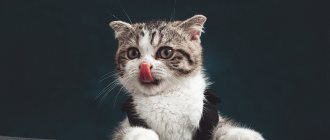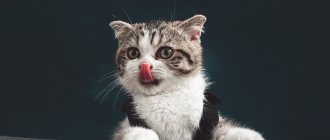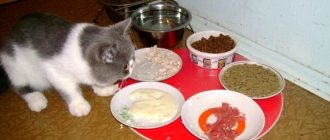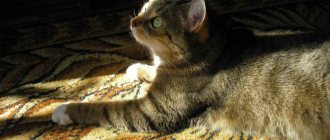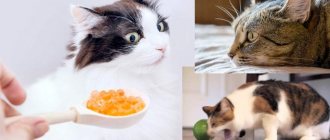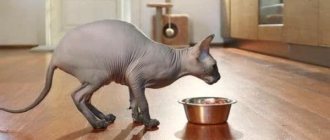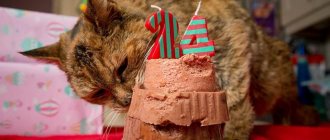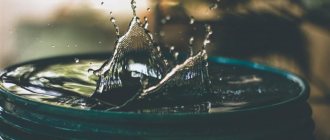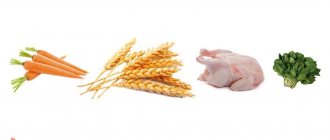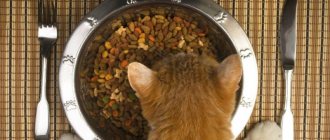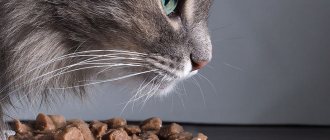Just like people, animals can change their eating habits and appetite over the years. This is not to mention that a kitten has one nutritional needs, while an older cat has different ones. Let's try to understand the most popular questions and misconceptions in this area.
| Don't ask a cat about its age Tough question: which cat should be considered senior? As with people, among the animals there are both cheerful pensioners and young people who have aged early. On average, you can focus on the seven-year mark, after crossing which most cats enter the category of seniors. But here everything is very individual. For example, cats that give birth regularly age earlier. The same applies to animals that happen to live on the street: even six months of “garbage” food can greatly age the body. And if your ten-year-old cat can jump onto a closet without a run and defeat the neighbor’s Doberman in a fair fight, he, like Carlson, can well be considered “in the prime of his life.” |
How many times should I feed?
If your cat eats natural food, then it is fed twice a day.
It is important not to overfeed the animal. The first sign that a cat is overeating: after eating, she leaves some food in the bowl.
This means that the amount of food you eat needs to be reduced. The animal must eat the entire amount at one time so that nothing is left in the bowl.
Does your cat eat dry food? It should always be freely available, but it is very important that the feeding rate is observed. The packaging of any dry food indicates the daily amount that should be consumed by the animal. Do not put more than this in the bowl, otherwise obesity may develop.
Criterias of choice
What to look for to avoid mistakes when choosing food for an elderly cat:
- Be able to understand the labels on packages in order to compare food from different manufacturers.
- Choose products from trusted manufacturers who invest heavily in developing optimal feeds.
- The specified composition must correspond to the age of the pet.
- Do not feed the animal only one food, change tastes and manufacturers.
- If necessary, strictly follow the veterinarian's recommendations.
Age characteristics of older cats
On average, aging in cats begins at 7–8 years. From this age, pets are considered to be elderly, and from 10–12 years old. Of course, these boundaries are conditional and are determined by the pet’s genetics, its lifestyle and nutrition. It will not be possible to avoid age-related changes, but it is possible to slow down their onset or mitigate their manifestations.
As cats age, they become less active and easily gain excess weight.
Age-related characteristics in cats include:
Veterinarians recommend monitoring the following signs of aging in pets:
- weight loss;
- decreased activity;
- change in the structure of the coat - it becomes stiffer;
- behavior change;
- loss of appetite;
- the emergence of picky eating.
What requirements should the diet of an elderly pet meet?
The main dietary requirements for an aging cat are:
- the use of high-quality protein for feeding a cat, complete in amino acid composition: for example, a lack of taurine can cause retinal dystrophy in an elderly pet and the development of blindness, as well as loss of muscle mass;
- limiting the content of phosphorus and sodium to improve the function of the urinary and cardiovascular systems;
- the increased content of vitamins, both fat-soluble (especially A and E) and water-soluble group B, helps slow down aging;
- sufficient content of polyunsaturated fatty acids and zinc to maintain good skin and coat condition.
There are different opinions regarding the amount of protein in food for older pets:
- some manufacturers slightly reduce its content, believing that this will reduce the load on the kidneys and protect them;
- others believe that in a healthy aging animal the need for quality protein even increases, and for cats with kidney failure there are veterinary diets, and high-protein diets are reserved for older pets.
It is very important to avoid sudden changes in diet in older cats, as the digestive system's ability to adapt to changes is greatly reduced. It is better to feed an older cat more often in smaller portions.
Particular attention should be paid to ensuring that the cat drinks. To do this, carefully monitor the purity of the water in the bowl and use a drinking fountain that is attractive to cats.
A drinking fountain can help encourage your cat to drink enough water; in addition, the water in it is saturated with oxygen
Video: Viyo drinks
How does food for an elderly cat differ from regular food?
Foods for elderly pets have a number of features:
the analytical composition has been changed - the fat content and total caloric intake have been reduced, conscientious manufacturers pay special attention to the quality composition of the protein, which helps maintain muscle mass, and the reduction in caloric intake helps to avoid the development of obesity; ingredients have increased digestibility; the composition must include dietary fiber that stimulates peristalsis; attention is paid to maintaining renal function - the amount of phosphorus is reduced, components are introduced that prevent the formation of stones in the urinary tract, usually these are polyionic complexes that optimize the acidity of urine; to support the immune system, feed must include antioxidants and vitamins; to improve the function of the musculoskeletal system, chondroprotectors are introduced into the feed, for example, mussel extract, glucosamine, chondroitin sulfate; to maintain the function of the cardiovascular system in feed, the sodium content is reduced and enriched with taurine and polyunsaturated fatty acids; The size of kibble for older pets is usually smaller, which makes them easier to chew and soak (if necessary).
What can wrong feeding lead to?
Improper feeding of an aging pet can result in a significant reduction in its life expectancy, as well as a decrease in its quality. According to statistics, the most common causes of death for domestic cats are:
- heart failure;
- renal failure;
- oncological diseases.
A balanced diet can reduce the risk of these diseases.
With age, the need for quality meat ingredients in cats only increases.
Foods that should not be given to cats
We often decide that products that are harmless to us will remain equally harmless to our pet. It’s not uncommon for us to treat our pets to food from the common table that, it would seem, cannot cause them any harm. But don’t rush to conclusions, even the most harmless products at first glance can cause irreparable harm to your pet.
Raisin
Never let your cat near grapes or raisins. These tasty and healthy foods for humans can cause great harm to your pet. The fact is that in a cat, raisins can cause almost instantaneous kidney failure.
It happens, of course, that they themselves steal some raisins from you or feast on grapes. If you notice this, be sure to watch your cat and, if you notice any strange behavior in its behavior, grab your pet and take it to the veterinarian. Symptoms can usually be noticed within the first 24 hours. This is usually weakness, loss of appetite, and decreased urination.
Onion
Onions are one of the most dangerous foods that should not be given to pets. Onion is a slow poison that destroys the red blood cells in the cat's body and causes anemia.
But don’t rush to think that your onion consumption is limited only to rings chopped into salads or stews. No, onions are a very insidious product that is added to semi-finished products, ready-made minced meat, spice bags and even baby food. Before treating your pet to anything from this list, read the ingredients.
Garlic
Garlic is much more dangerous than onions because it contains all the same substances, but in larger quantities. Fortunately, garlic is added to a limited number of foods, but you shouldn’t forget about it.
Alcohol and tobacco smoke
Alcohol and tobacco are inherently harmful not only to animals, but also to people. Many owners watch with affection the cat's reaction when their pet drinks a little beer or wine.
In general, tobacco and alcohol cause the same harm to them as to humans.
But take into account their size! These products are ten times more harmful for cats.
Bones
Never offer your pet chicken, fish or pork bones. During culinary processing, such products can cause internal injuries to the animal, which will have a bad effect on its well-being.
Milk and cream
There is a common belief that cream and milk are cat's favorite foods. Not at all, they can only be considered favorites among kittens, but not among adult animals. Adult animals are often lactose intolerant, which leads to dehydration.
List of common diseases
Often, minor symptoms of diseases can hide a number of serious illnesses. It is better to know about them in advance. After all, you can not only support the cat, but also help it overcome the disease.
A person can always tell what hurts and where it hurts; cats not only don’t talk about it, but also try to mask their illnesses. For example: people try to hide pain in the body behind a calmer lifestyle. They don’t jump to their favorite place, sleep a lot, and try to pester their owner less. With such signs, the animal should be taken to the veterinarian.
General symptoms:
- Problems with the digestive system may be hidden behind loss of appetite;
- Diseases of the genitourinary system are manifested by thirst or frequent urination;
- Problems with joints and pain when moving are usually manifested by lameness and a sedentary lifestyle;
- Frequent startling and disorientation can affect feline behavior.
It is important that the older the cat gets, the more often it is worth visiting the veterinarian. The doctor will help recognize diseases and eliminate pain.
Recommendations and advice on feeding sterilized cats
After sterilization, the cat’s lifestyle changes: he is no longer interested in cats, and all his attention switches to food. In many cases, a problem such as obesity arises some time after surgery. Most owners constantly give something tasty to their pet, feeling sorry for it
At the same time, many simply do not know that their metabolism is slowing down, and their diet also needs to be changed accordingly. As a result, weight increases and various diseases appear. For the longevity and health of your pet you need to follow some rules
Most owners constantly give something tasty to their pet, feeling sorry for it. At the same time, many simply do not know that their metabolism is slowing down, and their diet also needs to be changed accordingly. As a result, weight increases and various diseases appear. For the longevity and health of your pet, you need to follow some rules.
The main thing is not to overfeed the animal
It is very important to play with it for much longer. In most cases, the pet will begin to additionally beg food from other people (both family members and guests). Therefore, it is worth warning them and telling them about the great dangers of such snacks.
Therefore, it is worth warning them and telling them about the great dangers of such snacks.
If these recommendations are followed, but the cat continues to gain weight, it is necessary to give him a weekly fasting day.
It is also important to divide the daily diet into 4-5 parts and give them to your pet throughout the day, so he will be less likely to beg for more. Since he sleeps longer after sterilization, choose fun and entertaining games for him. There should always be enough water in the bowl
Although after surgery the cat needs to drink often and a lot, neutered animals may not understand this, drink less and, as a result, go to the toilet less
There should be a sufficient amount of water in the bowl at all times. Although after surgery a cat needs to drink often and a lot, neutered animals may not understand this, drink less and, as a result, go to the toilet less.
Over time, especially with the transfer to specialized dry food, the pet will begin to drink more. If this does not happen, you may need to consult your veterinarian about diuretics.
The content of calcium, magnesium and phosphorus should be reduced in the composition of pet food. An excess of these substances leads to damage to the genitourinary system and the formation of kidney stones. Such substances are found mainly in fish and dairy products - they must be completely excluded from the animal’s diet.
Often, some time after castration, animals may refuse to eat. This happens due to problems with teeth and gums. Therefore, you need to give your cat treats that massage the gums and maintain healthy teeth. It is imperative to give preventive medications against worms and special vitamins.
The most important thing is that due to changes in metabolism and other hormonal processes, the daily portion of food for your pet should be less than in the preoperative period!
Every owner or mistress wants to make the life of their pet as pleasant as possible and create conditions for their comfortable stay in the house.
An integral part of caring for pets is feeding; cats must have a balanced diet and therefore you need to choose food carefully and carefully
Types of feed
Dry
Produced in the form of dry granules with an optimal composition for cats aged 7+.
Advantages:
- balance;
- reduction of cooking time and feeding time;
- saving money;
- long shelf life.
Flaws:
- increased carbohydrate composition;
- harm to teeth;
- not enough moisture;
- presence of aromatic additives.
Wet
Canned food for aging pets, packaged in tins, lamisters, soft pouches or plastic pots. They consist of large or small pieces of meat or fish, vegetables or cereals, drenched in jelly or liquid sauce.
Advantages:
- large selection of flavors and textures;
- carb free;
- a lot of moisture;
- gentle processing.
Flaws:
- short shelf life;
- high price.
Types of feed by class:
- Holistic – the highest quality food without flavorings, dyes or other chemical additives. The ingredients are only of organic origin.
- Super-premium - contains a lot of meat products, sold in special pet stores.
- Premium - natural meat composition from chicken, high-quality by-products that are well digestible and safe for cats.
- Economy - cheap food with a minimum meat content (about 4%). Contains flavorings and dyes.
Requirements for natural products
Feeding cats natural food usually requires more time and resources, but this type of nutrition is more natural. It is quite difficult to prepare food that is balanced in all components at home.
With a natural diet at home, the cat should receive the following products:
- Meat. This is the basis of the diet. Chicken, veal, beef, and turkey are suitable for cats. You can also use various by-products. Usually cats love liver, stomachs, hearts.
- Cereals. Porridges are a source of slow carbohydrates that animals need for energy. However, porridge should not be the basis of the diet. You can feed your pet rice, oatmeal, and less often buckwheat.
- Fish. Also a source of proteins. In addition, it contains beneficial fatty acids and phosphorus. However, fish cannot replace meat in the diet. You can feed your cat fish about once a week.
- Dairy products. It is not necessary to give milk to adult cats. Whole milk often leads to digestive disorders. It is better to feed your cat low-fat cottage cheese or kefir, less often hard cheese.
- Vegetables. They are a source of vitamins, but cats don’t really like them.
Problems with well-being
If your pet has lost interest in food, the first thing you need to do is rule out health problems. Older cats (and it happens to young cats) sometimes refuse dry food due to problems in the oral cavity. In this case, the animal still wants to eat, but is afraid of chewing the pellets because it causes pain. Examine his mouth for redness of the gums, ulcers on the mucous membrane, and loose teeth.
If something like this is discovered, you need to contact a veterinarian and follow his recommendations. During the treatment period, dry food will have to be soaked or temporarily replaced with wet food.
Sometimes cats don't eat well because they're in heat or in hot weather. In this case, you just need to wait a little, and interest in food will return by itself. The main thing is not to forget about clean, fresh water: it should be freely available around the clock.
When, in addition to refusal to eat, other alarming symptoms are observed: fever, lethargy, vomiting or diarrhea, you should not hesitate to seek veterinary help. You should also sound the alarm if your pet eats absolutely nothing for 2-3 days.
Where can I buy
Popular models of dry and wet food for older cats can be found in pet stores or the pet supply sections of supermarkets. The best new and budget products can be viewed and checked there. If necessary, consultants will give valuable advice and recommendations - what they are, how to choose, which company is better, how much it costs, which one is better to buy.
If there is no good choice at your place of residence, you can order inexpensive, high-quality food from the best manufacturer online from the online store. Product cards, which present descriptions, features, photos, also contain direct links to the store to purchase the product.
Food for older cats can be purchased in the following packages:
- Dry at a price from 25 rubles (pack of 0.085 kg Perfect Fit with chicken) to 8,858 rubles (pack of 12 kg Savarra hypoallergenic with duck, rice).
- Wet - from 15 rubles (0.085 kg pack of Wiskas with chicken) to 5367 rubles (1 kg pack of Animonds Vom Feinsten Senior with lamb).
Natural products for cat exhaustion
The products from our table are not suitable for dietary therapy of cats with cachexia (moreover, such food is not suitable even for healthy animals). Our food may contain sugar, salt, spices, smoked meats, and dyes that are contraindicated for cats.
The cat must drink water. If she refuses to drink for more than a day, it is necessary to carefully pour in some water with a teaspoon.
This must be done very carefully, no more than two teaspoons at a time, every hour (until the cat starts drinking on its own)
In the first days of the diet, it is best to give your cat a light broth of white chicken meat and a little chopped boiled chicken breast. At night you can give about 2 tbsp. l. low-fat kefir. It is better not to feed raw meat yet; it takes much longer to digest.
On the third day of the diet, you need to start introducing other foods. Below is a list of approved foods for nutritional therapy for emaciated cats.
20 approved foods for malnourished cats:
- Boiled chicken breast.
- Raw beef meat, deveined.
- Turkey raw and boiled.
- Boiled beef.
- Boiled lamb meat.
- Boiled rabbit.
- A small amount of raw beef liver (a lot of liver acts as a laxative).
- Rice water.
- Raw chicken egg.
- Raw quail egg.
- Light chicken broth.
- Boiled sea fish.
- Boiled beef heart (minced).
- Low-fat kefir.
- Cottage cheese with low fat content.
- Sour cream (up to 15% fat content).
- Classic yogurt, without sugar and fruit fillers.
- Buckwheat (as a complement to meat).
- Rice cereal (as an addition to meat).
- Ready-made canned meat baby food.
All foods should be fresh, at room temperature or slightly warmer. For the first few days of diet therapy, portions should be very small, feeding approximately 5–6 times a day, 20 g each. Then portions and breaks between feedings can be increased.
Sour cream and cottage cheese are on the list of allowed foods, but you should not give them more than once a day. Raw yolk is always recommended for weakened, sick, post-operative pets. It is best to mix it with cottage cheese or boiled meat.
Listed below are foods that should not be included in a cat's diet. They are especially dangerous for weakened animals.
20 foods prohibited for feeding cats:
- Raw pork.
- Lard (in any form).
- Sausages.
- River fish.
- Bones.
- Chicken heads, paws, skins.
- Flour products.
- Smoked meats.
- Milk.
- Salt.
- Sugar.
- Spices.
- Starch.
- Onions in raw or heat-treated form.
- Green onions in any form.
- Condensed milk (often bred for kittens).
- Yeast dough.
- Tomato paste (primarily this applies to those who like to feed their cats sprat in tomato).
- Cabbage (provokes flatulence).
- Legumes.
How to feed a cat if he doesn't eat
When a cat is healthy and feels comfortable living in a house with its owners, there is no reason to force it to eat. Sometimes a pet is so passionate about getting food that it begs for it even more often than it really needs it. Typically, such cats always have a variety of food in their bowl, which they do not even eat completely. Therefore, an animal in normal health will always be interested in getting more goodies, and there will be no reason to force it to eat food.
Causes of decreased appetite in cats
If a beloved domestic cat suddenly stops eating well or refuses to eat at all, this immediately alerts the owners. The reasons that a pet does not eat food can be different. The most common reason is that the cat is overfed and his body requires unloading. This is the most harmless reason, which usually does not bring with it any bad consequences. But most often, cats eat poorly due to weakness and malaise, a clogged nose (the animal cannot smell the food), and also due to stress. Stress can be caused by a sudden rearrangement of furniture, moving, or lack of attention to the animal.
A caring owner will immediately discover that something is wrong with the cat if he has not touched food for a whole day. When a cat does not eat for more than two days, this is an indicator of a serious illness that needs to be treated. The most unpleasant thing is when a pet refuses food and water completely. He may lose serious weight and become very weak. This cannot simply be left alone, which is why veterinary practice often resorts to force-feeding animals.
Force feeding
In this case, you cannot think that the cat will start eating on its own in a couple of days. Most likely, he will need serious help and should be seen by a doctor as soon as possible. The most important thing is to understand why the animal stopped eating, became lethargic, and lost interest in life.
It is important to carry out all the necessary studies and even an ultrasound of the abdomen, since refusal to eat can be caused by abdominal pain, dysfunction of organs, as well as abscesses in the oral cavity. Force feeding includes:
Special diets
The result of the examination allows the doctor to immediately prescribe proper nutrition, a diet that will need to be strictly followed. But if the cat already eats poorly, then specialized food is unlikely to be to his taste. If a very small kitten is sick, you will even have to wake him up specifically to feed him. Alternatively, you can try finger feeding your baby, but you need to do it carefully, do not push your finger down his throat, and be a little more patient. Then the kitten will lick the food itself.
It is worth knowing that a very small kitten, which is not yet six months old, will not live even a day without food. Therefore, along with patience, you need to be persistent if you want to help your baby survive. An adult cat can live for two days, but this is all relative, because there are different diseases, more complex and milder.
Syringe feeding
For syringe feeding, the doctor prescribes veterinary pates, which are well diluted with water. If the food is dry, it needs to be soaked only with boiled, warm water. Before you start feeding, the food itself also needs to be warmed up, because it is its warm state that increases the aroma and can entice the kitten to try it. To force-feed your pet through a syringe, you need to hold the kitten by the head and gradually introduce food with a syringe without a needle.
Feeding solid foods
You need to watch the cat for a while. If the body positively perceives the portion of food that it managed to inject by force through a syringe, then over time you can give it more. If the diet is not too strict, then you can switch to homemade food - semolina, warm broths, dairy products. If, after a couple of days of feeding, the cat still does not eat on its own, then you can also force-feed it, but use solid food for this.
You can use regular food for adult animals and kittens, but soak it a little in milk to make it easier to swallow. Suitable pieces of boneless fish, minced meat, soft pieces of white bread. To do this, you need to take the cat under your left hand, unclench its teeth, and push a small piece from the side with your right hand. Then help her clench her jaws - most likely the cat will swallow the food. You should never mix medications into food - the animal will hear a foreign smell, and this may further discourage it from eating.
In order for the cat to recover quickly and begin to eat on its own, it is advisable to accompany each meal with pleasant emotions - talk to it affectionately and stroke it. Then your pet’s health will improve faster.
Features of the aging process
Aging is a process that is a set of unfavorable changes in the body, as a result of which the risk of cell death, tissue destruction and, ultimately, the death of a living being increases. This process is individual for each animal, although it has common features. For example, the “transience” of old age depends on many factors, such as genetics, ecology, quality of food and life, and many others. At the micro level, degradation manifests itself as disruption of cell function under the influence of free radicals, which leads to suppression of immune function, aging of genes and changes in chromosomes.
Loss of appetite
In such a situation, the best solution would be a pate bought in a store or prepared at home in a blender. If you have problems with digesting food, you can dilute your diet with fiber: the need for protein is no longer so strong, and fiber will stimulate the intestines, keeping it in good shape.
As you age, your risk of obesity increases dramatically. If a cat gains weight in old age, it will be almost impossible to put it on a diet and force it to lose weight. Sometimes, after a long period of loss of appetite, the animal regains its love for food. And in this case, it is important to balance the cat’s diet by increasing the number of daily food portions, but reducing their volume.
